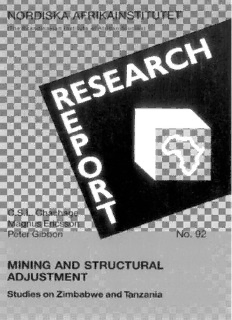
Mining and structural adjustment: studies on Zimbabwe and Tanzania PDF
Preview Mining and structural adjustment: studies on Zimbabwe and Tanzania
Research Report no. 92 Chachage Seithy L. Chachage Magnus Ericsson Peter Gibbon Mining and Structural Adjustment Studies on Zimbabwe and Tanzania Nordiska Afrikainstitutet (The Scandinavian Institute of African Studies) Uppsala 1993 Structural adjustment Typesetting: Kajsa Overgaard Language polishing: Elaine Almen ISSN 0080-6714 ISBN 91-7106-340-4 The authors and Nordiska Afrikainstitutet, 1993 Printed in Sweden by Motala Grafiska AB, Motala 1993 Contents Fore word Peter Gibbon MINING INVESTMENT, STRUCTURAL ADJUSTMENT AND STATE-MINING CAPITAL RELATIONS IN ZIMBABWE Magnus Ericsson and Peter Gibbon Abbreviations Exchange Rates Maps Introduction The Zimbabwean Mining Industry Investment Flows and Zimbabwean Mining Politics and Economic Policy in Post-Independence Zimbabwe The World Bank and African Mining Views from the Zimbabwe Mining Houses, 1991 Summary and Conclusion Appendix: Zimbabwe's Mining Legislation References NEW FORMS OF ACCUMULATION IN TANZANIA: THE CASE OF GOLD MINING Chachage Seithy L. Chachage Abbreviations Maps Themes for Discussion The Politics of Interpreting Economic Change in Tanzania Gold Mining in Tanzania Concluding Remarks References Foreword The mining industry was an important focus of scholarly and politi- cal discussion amongst Africans and Africanists during the 1970s. At this time most debate concerned the economic and political implica- tions of the seemingly inexorable expansion of the influence of multi-national mining houses, and of the actions of African states anxious to restrict their influence and gain access to their revenues. From the mid-1970s the interest uf these companies in most areas of Africa apparently declined, and discussion about African mining followed this same trend. The 1990s have seen a revival of interest in the topic of African mining for four reasons. Firstly, structural adjustment programmes have been adopted by most African governments. Amongst their central features is a more welcoming attitude to private capital in general and to foreign direct investment in particular. The World Bank and others envisage that those investors most likely to be at- tracted by this change are those with traditional experience of Afri- can investment. Most obviously, these include the mining houses. Secondly, this 'improvement' in the African investment climate is accompanied by certain problems attending further investment in the main growth centres of 1975-90, ie Australia and Canada. On the one hand, the best deposits are probably all now developed in these countries. On the other, increasingly restrictive environmental laws (and laws protecting the rights of indigenous peoples) limit the abil- ity of companies to exploit new prospects there. Thirdly, the prospect of a negotiated settlement in South Africa has already succeeded in allowing South African capital to overcome its long isolation and begin contemplating new external invest- ments. The obvious site for mining capital's expansion is elsewhere in Sub-Saharan Africa. Fourthly, there has been a growing acknowledgement of the scale and significance of small-scale or 'artisanal' mining in Africa. This has come about largely through an increased practical and academic interest in the growth of the informal sector generally during Africa's deepening economic crisis. These two studies, both produced as part of the SIAS research programme on 'The Political and Social Context of Structural Adjust- ment in Sub-Saharan Africa', reflect on these themes and others. In doing so they aim to provide up-to-date information on the coun- tries examined in a clear and accessible way. However, they do so from a specific shared perspective. The authors approach structural adjustment critically. Rather than seeing it as the necessary instrument of Africa's economic salva- tion, an effort is made to examine its concrete effects with regard to specific local situations and constellations of interests. The authors also systematically distinguish different interests within the mining industry, not only between countries but also be- tween different types of mining operations and their operators. Fi- nally they focus attention on the usually neglected social and politi- cal dimensions of the mining industry and in particular its relation to the national and local state in Africa. The paper by Chachage, moreover, contributes to the task of providing a theoretical framework linking each of these concerns. Uppsala, April 1993 Peter Gibbon Mining Investment, Structural Adjustment and State-Mining Capital Relations in Zimbabwe Magnus Ericsson and Peter Gibbon ABBREVIATIONS AAC Anglo American Corpor- UDI Unilateral Declaration of ation of South Africa Ltd Independence BHP Broken Hill Pty COL td UN United Nations CIL Carbon in leach UNIDO United Nations Industrial Cr Chromium Development Organisation CZI Confederation of USA ID US Aid Agency Zimbabwean Industry ZANU (PF) Zimbabwe African Na- EIU Economist Intelligence Unit tional Union (Patriotic Front) EPO Exclusive Prospecting Order ZAPU Zimbabwe African People's FER "Framework for Economic Union Reform 1991-95" ZCCM Zambian Consolidated GDP Gross Domestic Product Copper Mines IDA International Development ZISCO Zimbabwe Steel Corporation Agency IFC International Finance ZMDC Zimbabwe Mining Develop- Corporation (World Bank) ment Corporation IMF International Monetary ZNCC Zimbabwe National Fund Chamber of Commerce Kilogram ZUM Zimbabwe Unity Movement Thousand Zimbabwe ZWD Zimbabwe Dollars Dollars I.DC Less Developed Country LSCF Large-Scale Commercial Farming MGBP Million British Pounds EXCHANGE RATES MIGA Multilateral Investment (USD: ZWD) Guarantee Agreement MMCZ Minerals Marketing 1 = 0.62ZWD Corporation of Zimbabwe = 0.73ZWD MUSD Million US Dollars = 0.74ZWD MZWD Million Zimbabwe Dollars = 0.96ZWD OGIL Open General Import = 0.87ZWD Licence = 1.24 ZWD OPEC Organisation of Petroleum = 1.61 ZWD Exporting Countries = 1.66 ZWD OPIC US Government Investment = 1.89 ZWD Protection Guarantee = 2.23 ZWD Agreement = 2.53 ZWD PGM Platinum Group Metal = 4.95 ZWD SADCC Southern African = 5.20 ZWD Development Coordination Committee Metric ton L TNC Transnational Corporation TNDP "Transitional National Development Plan 1982-85" UANC United African National Congress (Muzorewa)
Description: